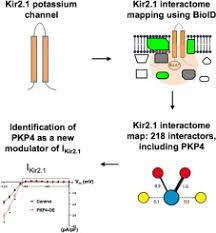Kir2.1 Interactome Mapping Uncovers PKP4
Kir2.1, a potent inward rectifier potassium channel encoded by the KCNJ2 gene, is a key regulator of cardiomyocyte resting membrane potential and plays an important role in controlling ventricular excitation and action potential duration in the human heart. KCNJ2 mutations lead to hereditary heart diseases in humans, e.g. Andersen-Tawil syndrome type 1 (ATS1).
Understanding the molecular mechanisms that govern the regulation of inward rectifying potassium currents by Kir2.1 in normal and pathological contexts should help uncover novel targets for therapeutic intervention in ATS1 and other Kir2.1-associated channelopathies. . The information available to date on protein-protein interactions involving Kir2.1 channels remains limited.

Further efforts are needed to provide a complete map of the Kir2.1 interactome. Here we describe the generation of a complete map of the Kir2.1 interactome using the BioID proximity labeling approach. Most of the 218 high-confidence Kir2.1 channel interactions we identified are novel and encompass diverse molecular mechanisms of Kir2.1 function, ranging from intracellular trafficking to interference with the factor receptor signaling pathway. insulin-like growth, as well as lysosomal pathways. degradation.
Our map also explores variations in the interactome profiles of Kir2.1WT compared to Kir2.1Δ314-315, a trafficking-deficient ATS1 mutant, thereby uncovering molecular mechanisms whose dysfunctions may underlie ATS1 disease. Finally, using patch-clamp analysis, we validate the functional relevance of PKP4, one of our main BioID interactors, for modulating Kir2.1-controlled inward rectifying potassium currents.
Our results validate the power of our BioID approach in identifying functionally relevant Kir2.1 interactors and underscore the value of our Kir2.1 interactome as a repository for many novel biological hypotheses about Kir2.1 and Kir2.1-associated diseases. Kir2.1.
The potent internal rectifier potassium channel Kir2.1 is a key regulator of cardiomyocyte resting membrane potential and plays an important role in controlling ventricular excitation and action potential duration in the human heart (1, 2, 3).
Loss-of-function and gain-of-function mutations in KCNJ2, the gene encoding Kir2.1, lead to inherited cardiac ion channel diseases. For example, several KCNJ2 loss-of-function mutations are associated with hereditary Andersen-Tawil syndrome type 1 (ATS1), also known as long QT syndrome type 7, which predisposes patients to cardiac arrhythmias and to sudden death (4, 5).
On the other hand, gain-of-function mutations of KCNJ2 give rise to the type 3 variant of short QT syndrome, which also leads to an increased risk of sudden cardiac death (6). Understanding the molecular mechanisms that govern the regulation of inward rectifying potassium currents by Kir2.1 in normal and pathological contexts should help uncover novel targets for therapeutic intervention in ATS1 and other Kir2.1-associated channelopathies. .
